Apple A1459 Tablet Device User Manual iPad User Guide
Apple Inc. Tablet Device iPad User Guide
Apple >
Contents
User Manual 2 of 8
Using and cleaning iPad
It’s important to nd a comfortable posture when using iPad, and to take frequent breaks. Use
your lap, or a table, case, or dock accessory, to support iPad during use.
Handle iPad with care, to maintain its appearance. If you’re concerned about scratching or
abrasion of the screen, you can use a case or a cover, sold separately.
To clean iPad, unplug all cables and turn o iPad (press and hold the Sleep/Wake button until the
red slider appears, then slide the onscreen slider). Use a soft, slightly damp, lint-free cloth. Avoid
getting moisture in openings. Don’t use window cleaners, household cleaners, aerosol sprays,
solvents, alcohol, ammonia, or abrasives to clean iPad. The iPad screen has an oleophobic coating;
simply wipe the screen with a soft, lint-free cloth to remove oil left by your hands. The ability of
this coating to repel oil will diminish over time with normal usage, and rubbing the screen with an
abrasive material will further diminish its eect and may scratch your screen.
For more information about handling iPad, see the iPad Important Product Information Guide at
support.apple.com/manuals/ipad.
23
Chapter 2 Getting Started
Draft
Apple Confidential
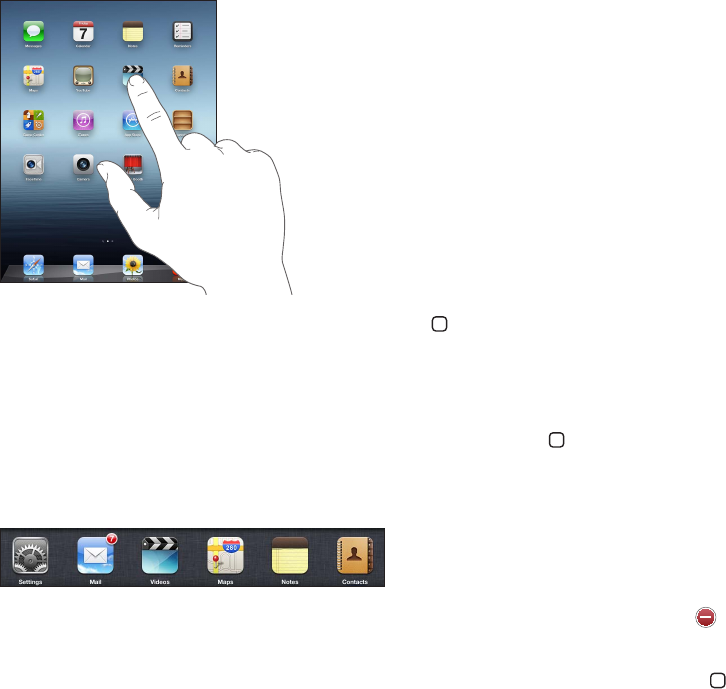
Basics 3
Read this chapter to learn how to use apps on iPad. You’ll also learn how to search, print, share
les, and more.
Using apps
The high-resolution Multi-Touch screen and simple nger gestures make it easy to use iPad apps.
Open an app by tapping its icon. You can switch between apps, rearrange apps, and organize
them in folders.
Opening and switching apps
Open an app: Tap its icon on the Home screen.
Return to the Home screen: Press the Home button , or pinch four or ve ngers together on
the screen.
Multitasking allows certain apps to run in the background, so you can quickly switch between the
apps you’re using.
View the most recently used apps: Double-click the Home button .
The most recently used apps appear in the multitasking bar at the bottom of the screen. Flick left
to see more apps.
Force an app to close: Touch and hold the app icon until it begins to jiggle, then tap .
The app is added to the recents list again, the next time you open it.
Lock the screen orientation or use the music controls: Double-click the Home button , then
ick along the bottom of the screen from left to right.
24
Draft
Apple Confidential
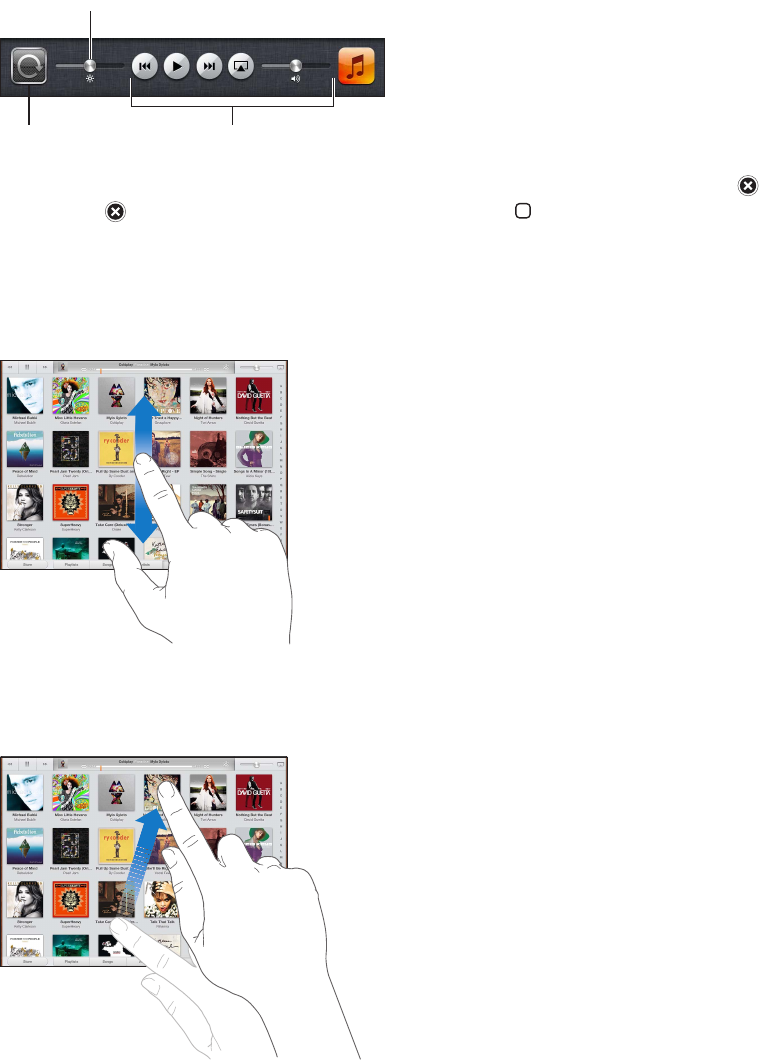
The screen orientation lock, brightness slider, and music controls appear.
Brightness
Brightness
Screen
orientation lock
Screen
orientation lock
Music
controls
Music
controls
Delete an app from the Home screen: Touch and hold the app icon until it jiggles and an
appears. Tap to delete the app, then press the Home button .
Important: Deleting an app from iPad also deletes the documents and data created by the app.
Scrolling
Drag up or down to scroll. You can also scroll sideways in apps such as Safari, Photos, and Maps.
Dragging your nger to scroll doesn’t choose or activate anything on the screen.
Swipe to scroll quickly.
You can wait for the scrolling to come to a stop, or touch anywhere on the screen to stop it
immediately. Touching the screen to stop scrolling doesn’t choose or activate anything on
the screen.
To quickly scroll to the top of a list, webpage, or mail message, tap the status bar at the top of
the screen.
25
Chapter 3 Basics
Draft
Apple Confidential
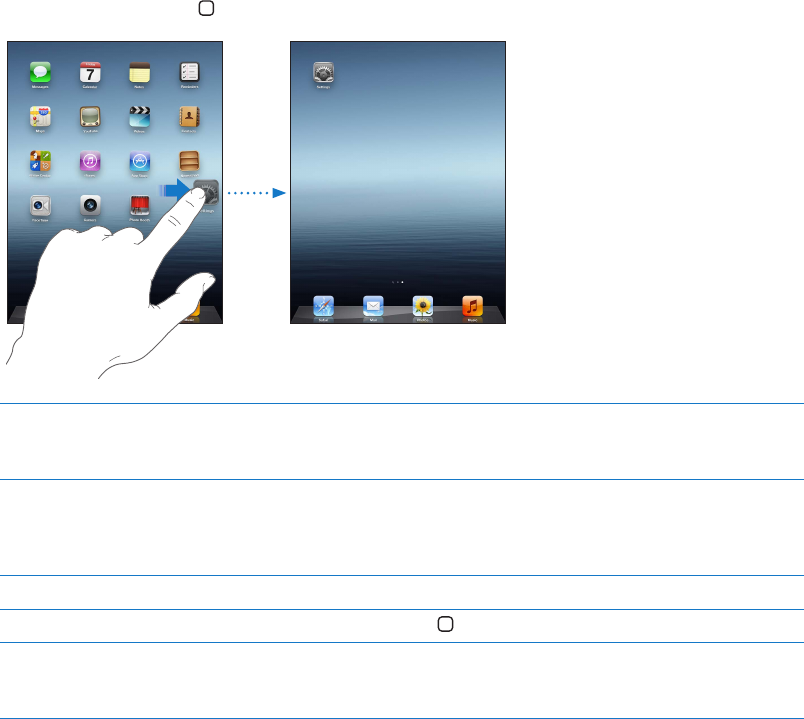
Customizing the Home screen
You can customize the layout of app icons on the Home screen—including the icons in the Dock
along the bottom of the screen.
Rearranging icons
You can create additional Home screens and arrange your apps over multiple Home screens.
Rearrange icons:
1 Touch and hold any app on the Home screen until it jiggles.
2 Arrange the apps by dragging them.
3 Press the Home button to save your arrangement.
Move an icon to another screen While arranging icons, drag an icon to the right edge of the screen until a
new screen appears. You can return to a previous screen and drag more
icons to the new screen.
Create additional Home screens While arranging icons, swipe to the rightmost Home screen, then drag an
icon to the right edge of the screen. You can create up to 11 Home screens.
The dots above the Dock show the number of screens you have, and which
screen you’re viewing.
Go to a dierent Home screen Flick left or right, or tap to the left or right of the row of dots.
Go to the rst Home screen Press the Home button .
Reset the Home screen to its
original layout
In Settings, go to General > Reset, then tap Reset Home Screen Layout.
Resetting the Home screen removes any folders you’ve created and applies
the default wallpaper to your Home screen.
When you connect iPad to your computer using the Dock Connector to USB Cable, you can
rearrange the icons on the Home screen, as well as the order of the screens, in iTunes. Select iPad
in the iTunes sidebar, then click the Apps tab.
26 Chapter 3 Basics
Draft
Apple Confidential
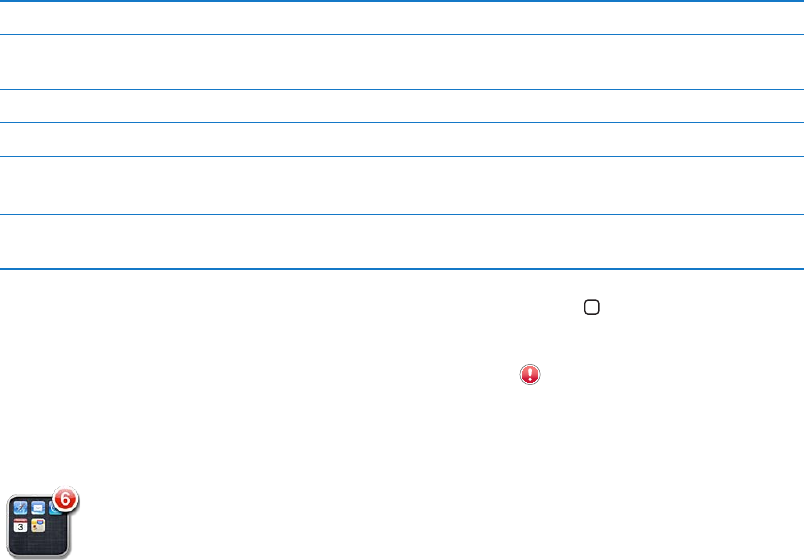
Organizing with folders
You can use folders to organize icons on the Home screen. You can put up to 20 icons in a folder.
iPad automatically names a folder when you create it, based on the icons you use to create the
folder, but you can change the name. Rearrange folders by dragging them on the Home screen or
by moving them to a new Home screen or to the Dock.
Create a folder: Touch and hold an icon until the Home screen icons begin to jiggle, then drag
the icon onto another icon.
iPad creates a new folder that includes the two icons, and shows the folder’s name. You can tap
the name eld to enter a dierent name.
Add an icon to a folder When the icons are jiggling, drag the icon onto the folder.
Remove an icon from a folder While arranging icons, tap to open the folder, then drag the icon out of
the folder.
Open a folder Tap the folder. You can then tap an app icon to open that app.
Close a folder Tap outside the folder, or press the Home button.
Delete a folder Remove all icons from the folder.
The folder is deleted automatically when empty.
Rename a folder While arranging icons, tap to open the folder, then tap the name at the top
and use the keyboard to enter a new name.
When you nish organizing your Home screen, press the Home button to save your changes.
Many apps, such as Mail and the App Store, display an alert badge on their Home screen icon with
a number (to indicate incoming items) or an exclamation mark (to indicate a problem). If the
app is in a folder, the badge appears on the folder as well. A numbered badge shows the total
number of items you haven’t attended to, such as incoming mail messages and updated apps to
download. An alert badge indicates a problem with the app.
Changing the wallpaper
You can choose the images or photos you want to use as wallpaper for your Lock screen and your
Home screen. Choose an image that came with iPad, or a photo from your Camera Roll album or
another album on iPad.
Set wallpaper:
1 In Settings, go to Brightness & Wallpaper, tap the image of the Lock and Home screens, then tap
Wallpaper or Saved Photos.
2 Tap to choose an image or photo. If you choose a photo, drag or pinch it to position or resize it,
until it looks the way you want.
3 Tap Set Lock Screen, Set Home Screen, or Set Both.
27
Chapter 3 Basics
Draft
Apple Confidential
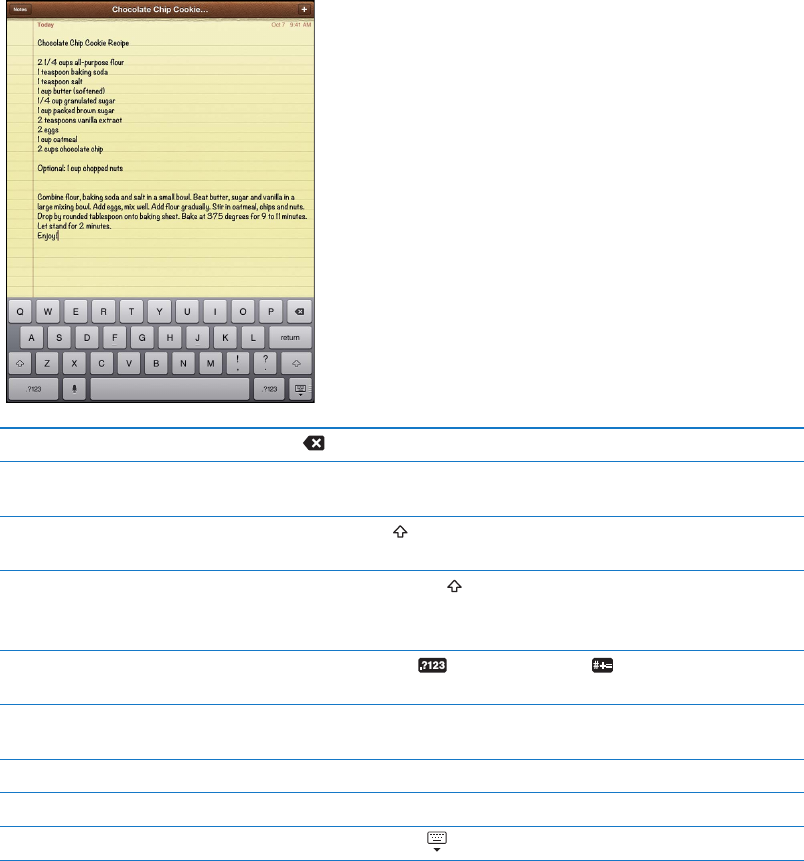
Typing
The onscreen keyboard appears automatically anytime you need to type. Use the keyboard
to enter text, such as contact information, mail, and web addresses. The keyboard corrects
misspellings, predicts what you’re typing, and learns as you use it.
You can also use an Apple Wireless Keyboard to type. When you use an external keyboard, the
onscreen keyboard doesn’t appear. See “Using an Apple Wireless Keyboard” on page 31.
Entering text
Depending on the app you’re using, the intelligent keyboard may automatically suggest
corrections as you type, to help prevent mistyped words.
Enter text: Tap a text eld, such as in a note or new contact, to bring up the keyboard, then tap
keys on the keyboard.
If you touch the wrong key, you can slide your nger to the correct key. The letter isn’t entered
until you release your nger from the key.
Delete the previous character Tap .
Quickly type a period and space Double-tap the space bar. To turn this feature o, go to Settings >
General > Keyboard.
Type uppercase Tap the Shift key before tapping a letter. Or touch and hold the Shift key,
then slide to a letter.
Turn caps lock on Double-tap the Shift key . The Shift key turns blue, and all letters you
type are uppercase. Tap the Shift key to turn caps lock o.
To turn this feature o, go to Settings > General > Keyboard.
Enter numbers, punctuation,
or symbols
Tap the Number key . Tap the Symbol key to see additional
punctuation and symbols.
Enter accented letters or other
alternate characters
Touch and hold the related key, then slide to choose a variant.
Use autocorrection to enter “’ll” Type “lll.” For example, type “youlll” to get “you’ll.”
Set options for typing Go to Settings > General > Keyboard.
Hide the onscreen keyboard Tap the Keyboard key .
28 Chapter 3 Basics
Draft
Apple Confidential
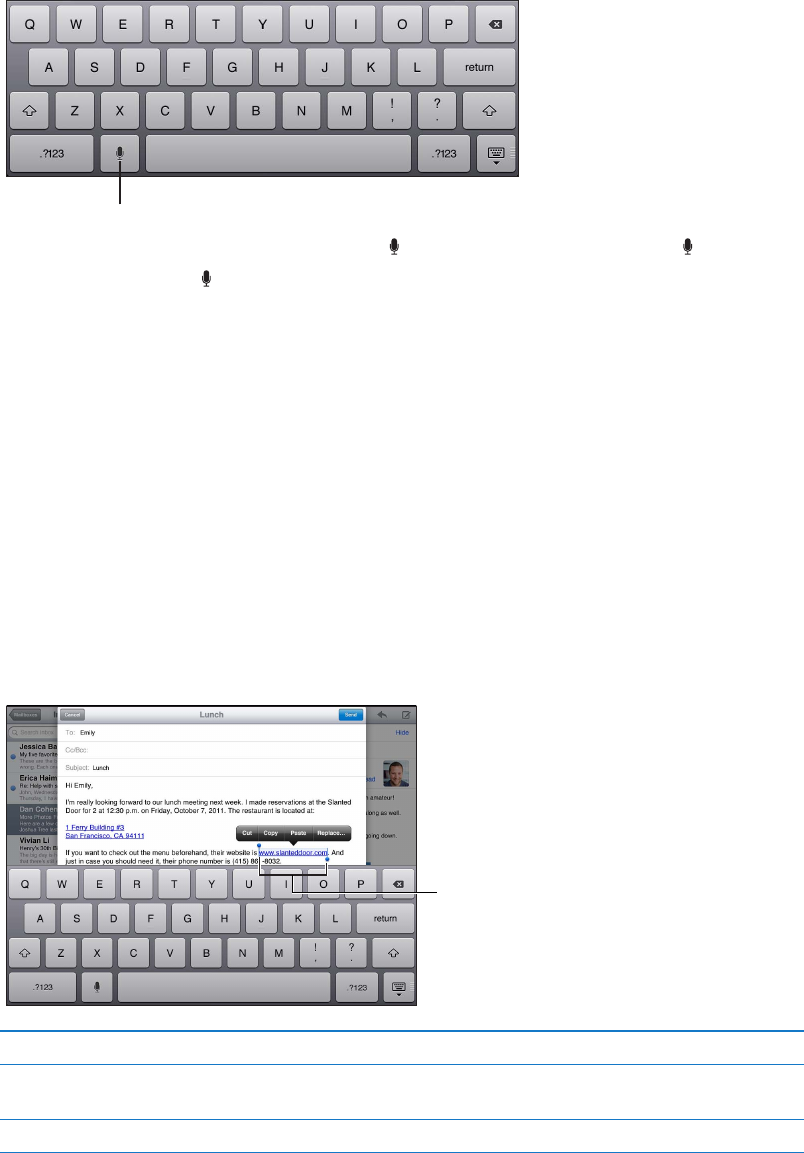
Dictation
On an iPad that supports dictation, you can dictate text instead of typing it on the onscreen
keyboard. For example, you can dictate a message in Mail or a note in Notes. To use Dictation,
iPad must be connected to the Internet.
Turn on Dictation: Go to, Settings > General > Keyboard > Dictation.
Tap to begin dictation.
Tap to begin dictation.
Dictate text: From the onscreen keyboard, tap , then dictate. When you nish, tap again.
Add to a message: Tap again and continue dictating.
Enter punctuation: Say the punctuation mark.
Note: Dictation may not be available in all languages or in all areas, and features may vary by area.
Cellular data charges may apply.
Editing text
The Multi-Touch screen makes it easy to change the text you’ve entered. An onscreen magnifying
glass helps you position the insertion point right where you need it. Grab points let you select
more or less text. You can also cut, copy, and paste text and photos within apps, or across apps.
Position the insertion point: Touch and hold to bring up the magnifying glass, then drag to
position the insertion point.
Select text: Tap the insertion point to display the selection buttons. Tap Select to select the
adjacent word, or tap Select All to select all text. You can also double-tap a word to select it.
Drag the grab points to select more or less text. In read-only documents, such as webpages, or
messages you receive, touch and hold to select a word.
Grab points
Grab points
Cut or copy text Select text, then tap Cut or Copy.
Paste text Tap the insertion point, then tap Paste to insert the last text that you cut or
copied. Or, select text, then tap Paste to replace the text.
Undo the last edit Shake iPad.
29
Chapter 3 Basics
Draft
Apple Confidential
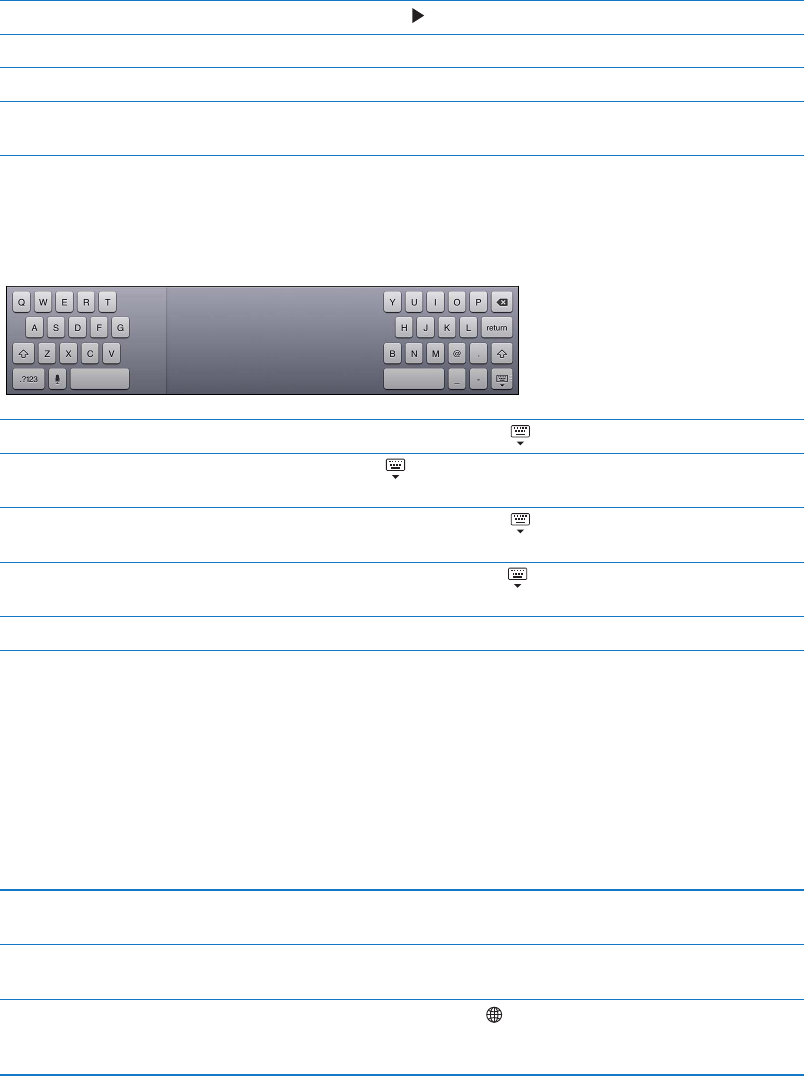
Make text bold, italic, or underlined When available, tap , then tap B/I/U.
Find a denition for a word Tap a word to select it, then tap Dene.
Find alternative words Tap a word, tap Select, then tap Suggest, and tap a suggested word.
Justify text When available, select the text you want to justify, then tap the left arrow or
the right arrow.
Keyboard layouts
On iPad, you can type with a split keyboard that’s at the bottom of the screen, or undocked and in
the middle of the screen.
Use a split keyboard Touch and hold the Keyboard key , slide your nger to Split, then release.
Move the keyboard Touch and hold , slide your nger to Undock to move the keyboard to
the middle of the screen, then release.
Return to a full keyboard Touch and hold the Keyboard key , slide your nger to Dock and Merge,
then release.
Return a full keyboard to the
bottom of the screen
Touch and hold the Keyboard key , slide your nger to Dock, then release.
Turn Split Keyboard on or o Go to Settings > General > Keyboard > Split Keyboard, then tap On or O.
You can use Settings to set the layouts for the onscreen software keyboard and for any hardware
keyboards. The available layouts depend on the keyboard language. See Appendix B, “International
Keyboards,” on page 132.
For each language, you can choose dierent layouts for the onscreen software keyboard and for
any external hardware keyboards. The software keyboard layout determines the layout of the
keyboard on the iPad screen. The hardware keyboard layout determines the layout of an Apple
Wireless Keyboard connected to iPad. See “Using an Apple Wireless Keyboard” on page 31.
Select a hardware or software
keyboard layout
Go to Settings > General > International > Keyboards, tap a language, then
choose a software or hardware keyboard layout.
Add or remove an
international keyboard
Go to Settings > General > International > Keyboards.
Use an international keyboard Touch and hold the Globe key on the onscreen keyboard to display a
list of enabled languages, then slide your nger to choose a language. See
Appendix B, “International Keyboards,” on page 132.
30 Chapter 3 Basics
Draft
Apple Confidential
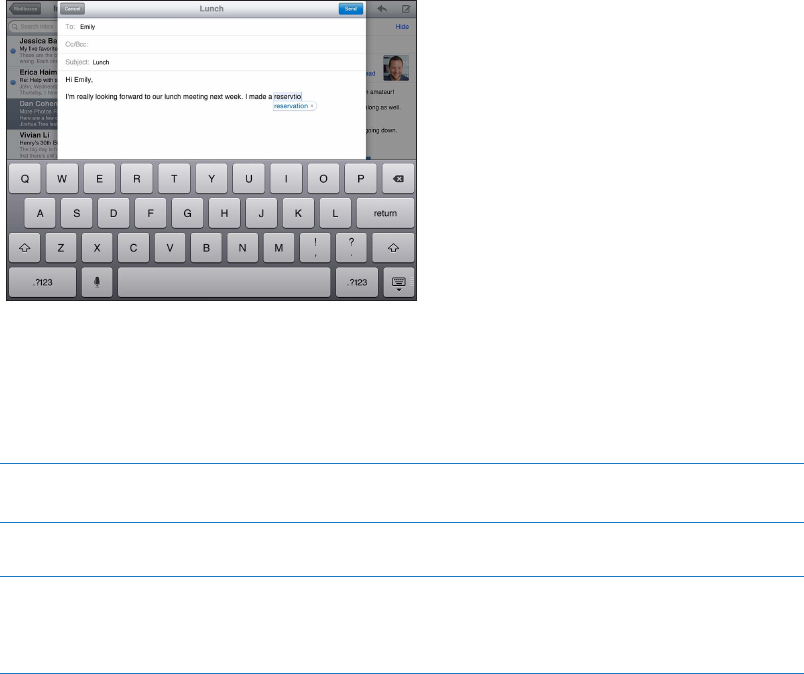
Auto-correction and spell checking
For many languages, iPad automatically corrects misspellings or makes suggestions as you type.
When iPad suggests a word, you can accept the suggestion without interrupting your typing.
Accept the suggestion: Type a space, punctuation mark, or return character.
Reject a suggestion: Finish typing the word as you want it, then tap the “x” next to the suggestion.
Each time you reject a suggestion for the same word, iPad becomes more likely to accept the word.
iPad may also underline words you’ve already typed that might be misspelled.
Replace a misspelled word Tap the word, then tap one of the alternate spellings.
If the word you want doesn’t appear, just retype it.
Turn auto-correction or
spell checking on or o
Go to Settings > General > Keyboard.
Add a word to the
keyboard dictionary
Go to Settings > General > Keyboard. Tap Add New Shortcut. Enter the
word in the Phrase eld, but leave the Shortcut eld blank. This adds
the word to the keyboard dictionary and it won’t be identied as being
misspelled when you type it.
Shortcuts
Shortcuts lets you type just a few characters instead of a longer word or phrase. The expanded text
appears whenever you type the shortcut. For example, the shortcut “omw” expands to “On my way!”
Create a shortcut: Go to Settings > General > Keyboard, then tap Add New Shortcut.
To add a word or phrase to the keyboard dictionary so that iPad doesn’t try to correct or replace it,
leave the Shortcut eld blank.
Edit a shortcut: Go to Settings > General > Keyboard, then tap the shortcut.
Using an Apple Wireless Keyboard
In addition to the onscreen keyboard, you can also use an Apple Wireless Keyboard with iPad.
The Apple Wireless Keyboard connects using Bluetooth, so you must pair the keyboard with iPad.
See “Pairing Bluetooth devices” on page 37.
Once the keyboard is paired with iPad, it connects whenever the keyboard is within range (up to
33 feet or 10 meters). You can tell that the keyboard is connected if the onscreen keyboard doesn’t
appear when you tap in a text eld.
Switch the language when using a hardware keyboard: Hold down the Command key and tap
the space bar to display a list of available languages. Tap the space bar again to choose a language.
31
Chapter 3 Basics
Draft
Apple Confidential
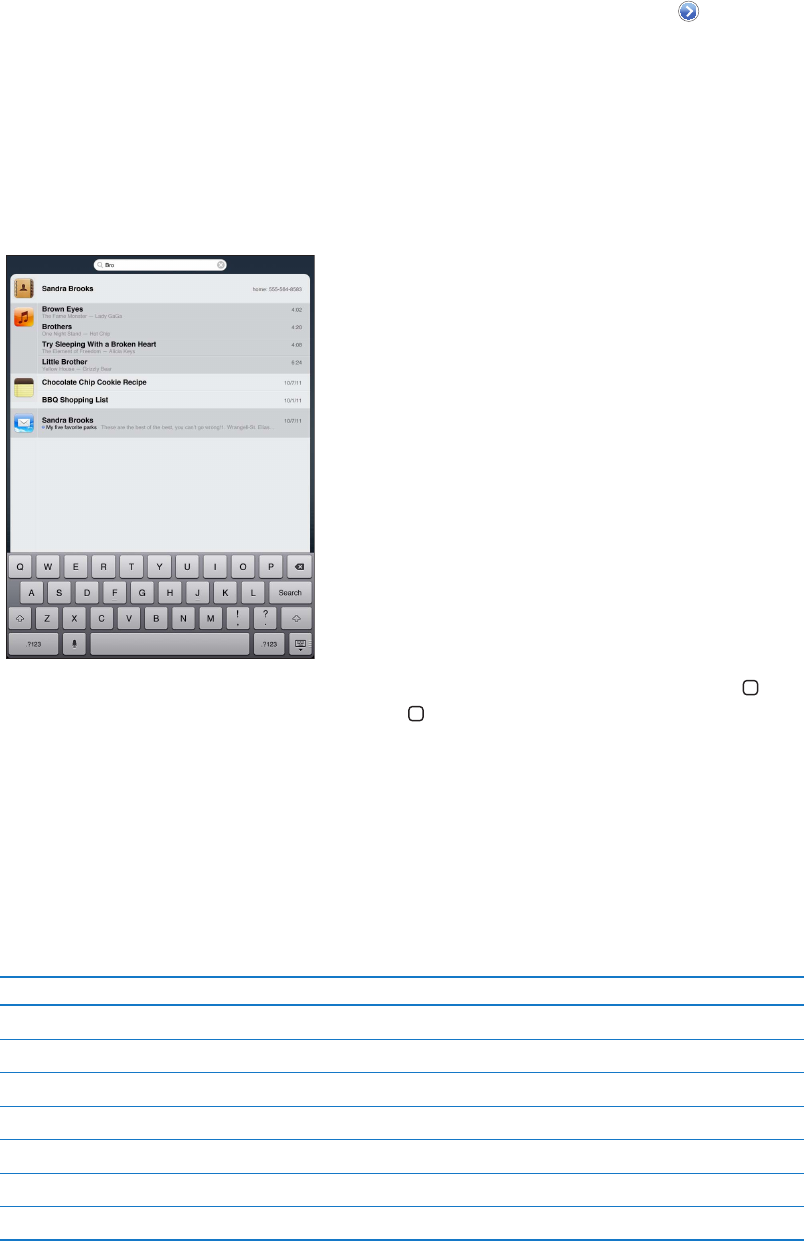
Disconnect a wireless keyboard from iPad: Hold down the power button on the keyboard until
the green light goes o.
iPad disconnects the keyboard when it’s out of range.
Unpair a wireless keyboard from iPad: In Settings, go to General > Bluetooth, tap next to the
keyboard name, then tap “Forget this Device.”
You can apply dierent layouts to a wireless keyboard. See Appendix B, “International
Keyboards,” on page 132 and “Keyboard layouts” on page 30.
Searching
You can search iPad‘s built-in apps, including Mail, Calendar, Music, Video, Notes, and Contacts.
Search an individual app, or search all the apps at once using Spotlight.
Go to Search: On the main page of the Home screen, ick right or press the Home button . On
the Search page, you can press the Home button to return to the main Home screen.
Search iPad: On the Search page, enter text in the Search eld. Search results appear
automatically as you type. Tap Search to dismiss the keyboard and see more of the results.
Tap an item in the results list to open it. Icons to the left of the search results let you know which
app the results are from.
At the top of the list, iPad shows your top hits based on previous searches. At the bottom of the
list, the search results also include options to search the web or search Wikipedia.
Here’s a list of the apps searched and what information is searched within each app:
App What’s searched
Contacts First, last, and company names
Mail To, From, and Subject elds of all accounts (the text of messages isn’t searched)
Calendar Event titles, invitees, locations, and notes
Music Music (names of songs, artists, and albums) and the titles of podcasts, videos, and audiobooks
Notes Text of notes
Messages Names and text of messages
Reminders Titles
32 Chapter 3 Basics
Draft
Apple Confidential
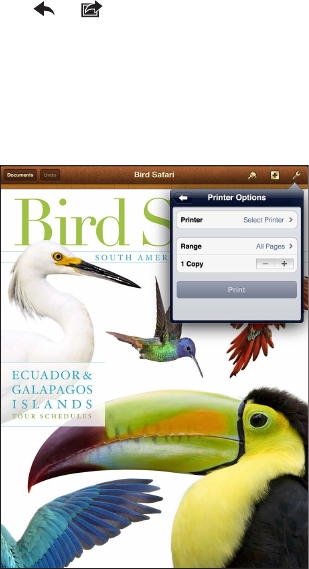
Search also searches the names of built-in and installed apps on iPad. If you have a lot of apps,
you can use Spotlight to locate and open them.
Open an app from Search: Enter all or part of the app name, then tap to open the app.
You can choose which apps are searched and the order they’re searched in. In Settings, go to
General > Spotlight Search.
Printing
iPad can print wirelessly to AirPrint-enabled printers. You can print from the following iPad
built-in apps:
Mail—email messages and viewable attachments Â
Photos and Camera—photos Â
Safari—webpages, PDF les, and viewable attachments Â
iBooks—PDF les Â
Notes—currently displayed note Â
Maps—view of map showing on the screen Â
Other apps available from the App Store may also support AirPrint.
An AirPrint-enabled printer doesn’t require printer software; it just needs to be connected to the
same Wi-Fi network as iPad. If you’re not sure whether your printer is AirPrint-enabled, refer to its
documentation.
For more information about AirPrint, go to support.apple.com/kb/HT4356.
Printing a document
AirPrint uses your Wi-Fi network to send print jobs wirelessly to your printer. iPad and the printer
must be on the same Wi-Fi network.
Print a document:
1 Tap or (depending on the app you’re using), then tap Print.
2 Tap Select Printer to select a printer.
3 Set printer options, such as number of copies and double-sided output (if the printer supports it).
Some apps also let you set a range of pages to print.
4 Tap Print.
33
Chapter 3 Basics
Draft
Apple Confidential
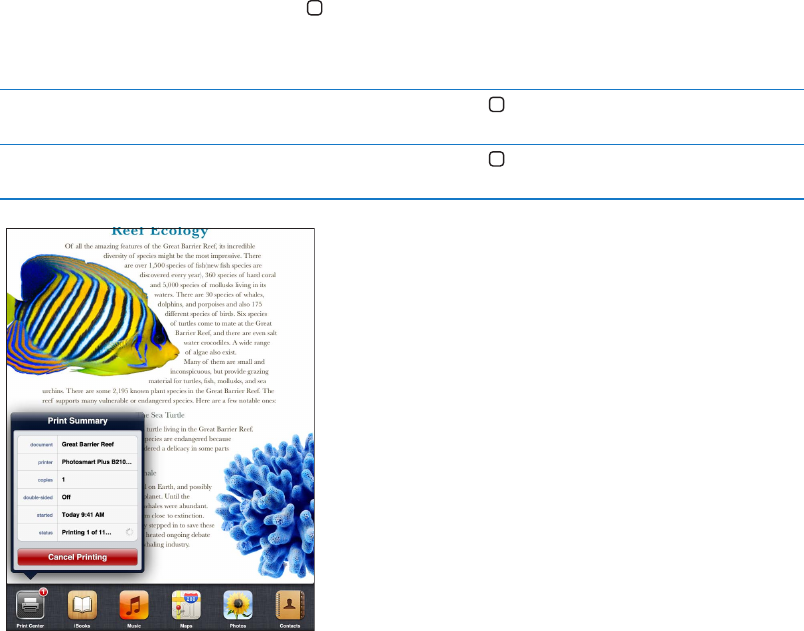
If you double-click the Home button while a document is printing, the Print Center app appears
as the most recent app. A badge on the icon shows how many documents are ready to print,
including the currently printing document.
See the status of a print job Double-click the Home button , tap the Print Center icon, then select a
print job.
Cancel a print job Double-click the Home button , tap the Print Center icon, select the print
job, then tap Cancel Printing.
File Sharing
File Sharing lets you transfer les with the Dock Connector to USB Cable between iPad and
your computer, using iTunes. You can share les created with a compatible app and saved in a
supported format.
Apps that support le sharing appear in the File Sharing Apps list in iTunes. For each app, the Files
list shows the documents that are on iPad. See the app’s documentation for how it shares les; not
all apps support this feature.
Transfer a le from iPad to your computer: In iTunes, go to your device’s Apps pane. In the File
Sharing section, select an app from the list. On the right, select the le you want to transfer, then
click “Save to.”
Transfer a le from your computer to iPad: In iTunes, go to your device’s Apps pane. In the File
Sharing section, select an app, then click Add. The le is immediately transferred to your device for
use with the app you selected.
Delete a le from iPad: In iTunes, go to your device’s Apps pane. Select the le in the Files list in
the File Sharing section of the Apps pane, then press the Delete key.
34 Chapter 3 Basics
Draft
Apple Confidential
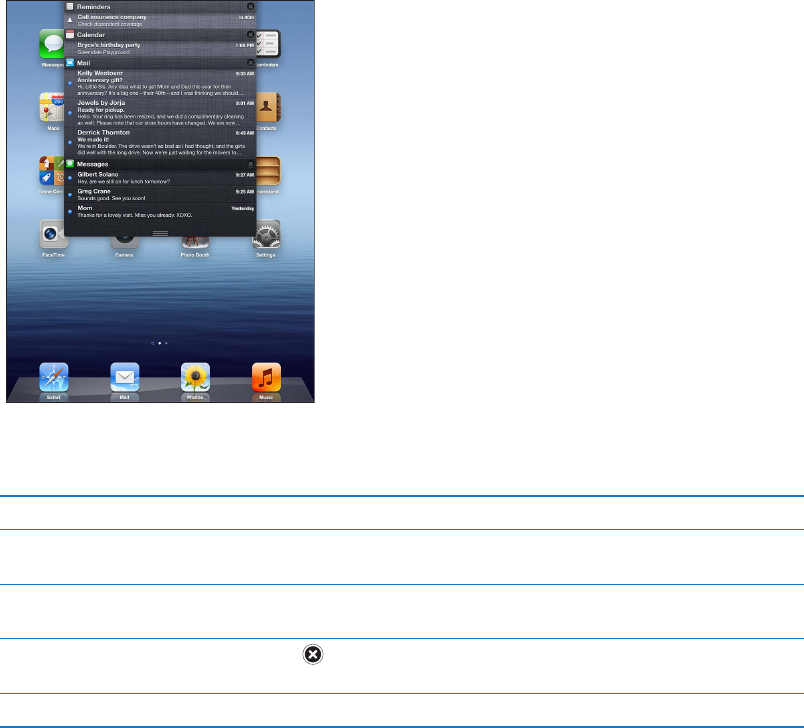
Notications
Notication Center displays all your alerts in one place, including alerts about:
Reminders Â
Calendar events Â
New mail Â
New messages Â
Friend requests (Game Center) Â
Alerts also appear on the lock screen, or briey at the top of the screen when you’re using iPad.
You can see all current alerts in Notication Center.
Show Notication Center Swipe down from the top of the screen.
Respond to an alert in
Notication Center
Tap the alert.
Respond to an alert on the
lock screen
Swipe the alert from left to right.
Remove an alert from
Notication Center
Tap , then tap Clear.
Set options for notications Go to Settings > Notications.
35
Chapter 3 Basics
Draft
Apple Confidential
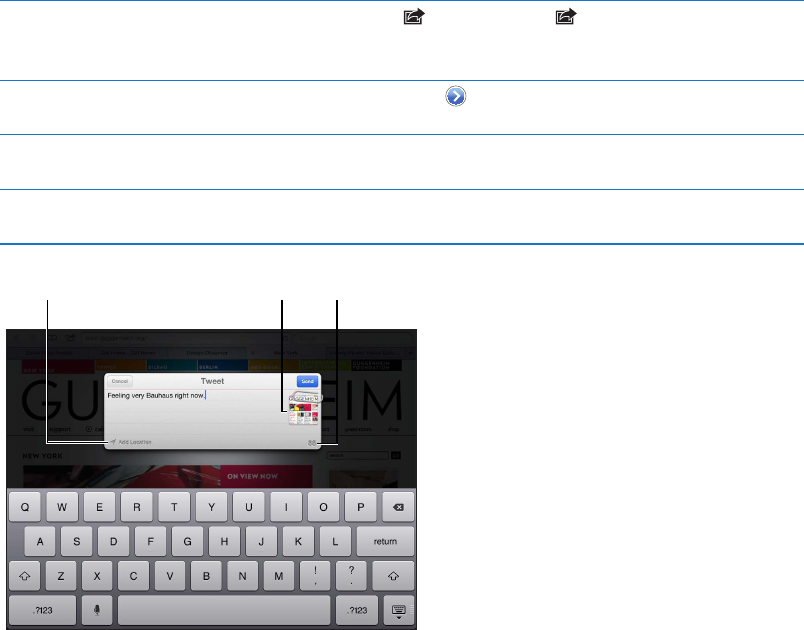
Twitter
Sign in to your Twitter account (or create a new account) in Settings to enable Tweets with
attachments from the following apps:
Camera or Photos—with a photo from your Camera Roll album Â
Safari—with a webpage Â
Maps—with a location Â
YouTube—with a video Â
Sign in to (or create) a Twitter account:
1 Go to Settings > Twitter.
2 Enter the user name and password for an existing account, or tap Create New Account.
To add another account, tap Add Account.
Tweet a photo, video,
or webpage
View the item, tap , then tap Tweet. If isn’t showing, tap the screen.
To include your location, tap Add Location. Location Services must be on.
Go to Settings > Location Services.
Tweet a location in Maps Tap the location pin, tap , tap Share Location, then tap Tweet. Location
Services must be on. Go to Settings > Location Services.
Add Twitter user names and
photos to your contacts
Go to Settings > Twitter, then tap Update Contacts.
Turn Twitter on or o for
Photos or Safari
Go to Settings > Twitter.
Add your
current location
Add your
current location
Attachment
Attachment
Available
characters remaining
Available
characters remaining
When you’re writing a Tweet, the number in the lower-right corner of the Tweet screen shows
the number of characters remaining that you can enter. Attachments use some of a Tweet’s
140 characters.
You can install and use the Twitter app to post a Tweet, view your timeline, search for trending
topics, and more. In Settings, go to Twitter, then tap Install. To learn how to use the Twitter app,
open the app, tap the More button (…), tap Accounts & Settings, tap Settings, then tap Manual.
36 Chapter 3 Basics
Draft
Apple Confidential